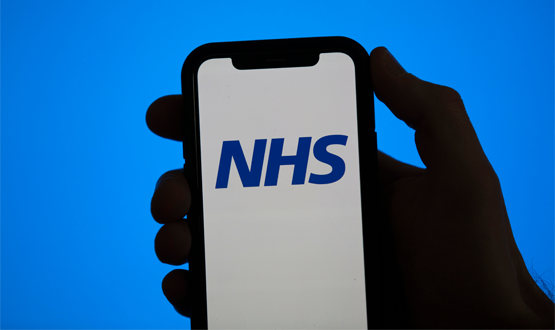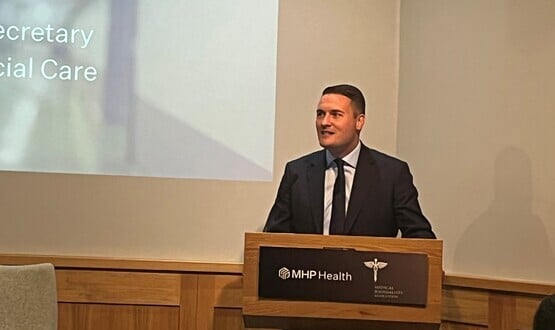Un’appy times – the challenges facing the NHS App

The NHS App that launched at the end of December is a prestige project on the road to NHS digitisation, championed first by Jeremy Hunt and now by Matt Hancock. But it’s just lost two of its key leaders and will have to overcome serious technical challenges if it is to become the default digital gateway for patients. Digital Health editor Jon Hoeksma reports.
The NHS App has been loaded up with headline-catching public commitments by two successive health secretaries. The simple fact is it will struggle to keep them.
The pledge which grabbed most attention was the one to end the 8am phone scramble to make a GP appointment. Instead, the app was to make online appointment booking available to all.
Less discussed, though potentially more significant, is the ambition for the NHS App to be the future digital gateway into the NHS. Under this vision, the app would develop into the standard platform by which citizens access a range of local and national digital health services and apps.
Key to this concept is the idea of NHS login, which provides a common NHS account and identity for the first time. Currently in testing, and due to be available to all this year, creating an NHS login will involve using a video selfie and snapping a pic of an identity document – akin to creating an account with an online bank like Monzo.
It is this long-promised NHS login – originally conceived as a standalone federated identity service – that is meant to really separate the NHS App from currently available NHS digital services.
Deadlines on the approach
But for people to be able to use the app to book appointments – as well as to access records and test results – their practice first up to hook up to the e-Referral Service and summary care record.
During a beta from September to December 2018, the app was rolled out to 34 GP practices. NHS England says that it now plans to work with the remaining 7,300 English practices to have them enabled by the end of July.
There is already another key deadline sitting at the end of July. The latest GP contract, agreed by the BMA last week, requires practices to publish 25% of their appointments online by the end of that Summer month.
Rather than end the 8.00am telephone scramble for GP appointments the app may just shift it online, so patients will soon be trying to book on the phone while they also hit refresh on their iPad.
But there are suggestions the concept itself is an attractive one to patients. Patient Access – at time of writing, number two in the Apple App Store in the medical category – already provides access to GP records, appointments and test results. But that’s only if your practice is running EMIS and supports online access (and, furthermore, different practices support different levels of access).
Creating a coherent picture
Consider the NHS Long Term Plan promise that local health care records will cover the whole country by 2024, and NHS England’s plan to create a market for locally commissioned digital services, and the picture becomes more fragmented still.
In total, NHS England plans to spend £35m stimulating the market in local digital services over the next three years, including extending into new areas like population health management, with the majority of such services expected to be purchased through a new framework.
And behind the scenes, NHS England has also played a market maker for digital services, including enabling Hammersmith and Fulham CCG to commission GP at Hand from Babylon – and then footing the costs so the service could keep going.
The theory is different to the practice
So just how will the NHS App serve as the gateway to all of these NHS commissioned digital services? The idea is that when users login, they will be shown a directory of locally commissioned digital services available to them. Through the use of NHS login and APIs, patients will then be able to seamlessly connect to these third party services from within the NHS App.
The first priority areas for connecting with third party services are video consultations and online symptom checkers, where proof of concept work has been done with companies including eConsult, Dr. iQ, EMIS (through the aforementioned Patient Access), Livi and Babylon.
A January report from the Empower the Person team, however, highlights some serious problems with the platform-based approach. Most significant is that some key players, including Livi, don’t have APIs to connect to the NHS App.
The NHS England report is quoted as saying Livi has “no external APIs available, so app-to-app integration is the only technically feasible pattern”.
But the report makes clear that such a solution, or indeed deep linking, would be less-than-ideal and potentially lead to a poor experience for patients.
It would also be sharply at odds with ministerial commitments on interoperability.
In September 2018 the secretary of state for health and care Matt Hancock said: “We are going to be extremely robust with any supplier who doesn’t live up to the new standards we are mandating. I want all our existing suppliers to come with us on this journey. But if you don’t want to come on this journey, you won’t be supplying IT to the NHS.”
He’s made many similar public proclamations since. That some of the new digital health providers aren’t yet playing ball on interoperability, standards and APIs is embarrassing. Even more embarrassing is the fact that Juliet Bauer, chief digital officer NHS England, has just jumped ship to Livi.
Changing faces but the same challenges
Bauer was criticised for an article published in The Times (for whose publisher, News International, she previously worked) in which she praised Livi without mentioning that she’d just taken a job with the company.
And in another senior departure Andy Callow, the NHS App programme director, has just been named as the new chief digital and information officer for Kettering General Hospital NHS Foundation Trust.
Tara Donnelly – chief executive of the academic health science network for South London and on the management board at DigitalHealth.London – has now stepped in as interim chief digital officer at NHS England. She will take over the Empower the Person workstream (formerly known by the less catchy name of Domain A). Perhaps the NHS App team will move into NHSX, the rumoured new digital unit in the Department of Health and Social Care.
But no matter the precise structures and the makeup of the teams, there is little doubt that making the NHS App live up to the hype while also keeping broader promises is going to be a very tricky challenge indeed.





5 Comments
We do need an NHS app , but get real, @ this point in time it should be view only and available to all. Please, let’s keep IT real !
Hmmmm.
“Rather than end the 8.00am telephone scramble for GP appointments the app may just shift it online…”
This is already the case at my own GP practice which uses SystmOne. Canny patients have worked out the exact day and time when the next week’s batch of appointment slots are published online. There’s a mad scramble to book online appointments, not helped when the GPs tell patients to “book a follow up appointment in 2 weeks, knowing full well that there are already no slots available!
We seem to be reverting to the situation where politicians announce when new services will be generally available before the new business processes and associated enabling technology have been piloted at scale,
Does this remind anyone of the grand plans and challenging timetables announced for Universal Credit or NPfIT – both of which also had major leadership retention issues?
” But for people to be able to use the app to book appointments – as well as to access records and test results – *their practice first up to hook up to the e-Referral Service and summary care record.* ”
-why? Neither of these have anything to do with booking GP appointments (eRS is for secondary care) or record access (SCR is only clinician-facing)
The problem posed around Patient Access only being able to link up with EMIS practice sites – Evergreen Life is available across EMIS, TPP and Vision and has been for over a year. We are not short of technology that already provides online patient services, and it seems a hefty investment for the NHS app to reinvent the wheel.
Supporting practices and educating them to promote online services (mentioning PFS face to face, at certain points in their GP visit) is key here and there seems to be no plan to encourage and support people to access the solutions already available.
Lots of issues here.
The practice at which I’m a a patient, like many, operates a callback systems with 100% GP triage. Not everyone likes this, but it works for me and ensure the best use of scarce GP appointments.
Given that we don’t have the resources in primary care to service the potential demand we have to very careful that we don’t introduce online appointment systems that favour those who probably don’t need to see a GP versus those who do but are less digitally literate.
I’ve lost track of how the NHS login works. At one time plans seemed remarkable sensible with an intention to use openID – This is the same open standard technology that allows you to logon to many services with your google, facebook or twitter credentials and is fully capable of meeting NHS requirements – This doesn’t mean, and I’m not suggesting, that you should, be able to login to your GP practice with your facebook credentials.
If they have stuck to this – It was very sensible, so they probably haven’t – Then it would be a simple matter to use your NHS login to connect to any service that chose to trust it, you don’t need a platform for this (although an open platform is not a bad idea) and you only need the NHS App for the creation of your NHS login. You wouldn’t need to connect through it.
All a service like Livi need to do is to support openID (there are fee open source components that make this trivially easy) and decide it trusts the identity verification provided by the NHS. Somebody tell me that this simple approach has not be screwed up?
It would seem to make sense for a service like Livi to do this and to expose an API to allow he easy integration of their service into other applications.
Comments are closed.